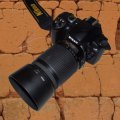BANKSY mampisaina
Nampidirin'i radotiana | 24 Okt, 2006Tsy aritro ka dia naleoko nanokanana pejy iray ato amin'ny blaogiko ity "Guerrilla Street Artist" iray ity. Asa na efa mba henonao fa misy an'izay magazine malaza antsoina hoe Esquire izay aty Etazonia. Tapakevitra ry zareo ary fa hanome ny anaram-boninahitra " artist of the year " an'i BANKSY. Ireny olona mpanoratsoratra sy mpanao sary amin'ny rindrina amin'ny "spray paint" ireny izy io. Any Angletera izy no mipetraka. Ny tena olana dia tsy misy mahalala hoe iza marina ity Banksy ity fa ny asa-tanany mipetraka eny amin'ny rindrin'olona no ahafantarana fa nandalo teo izy.
Nisy fotoana aza moa dia afaka nametraka ny sangan'asany tao amin'ny rindrin'ny British Museum any Angletera ny tenany. Sary mainty sy fotsy mampiasa stencil (Ireo mpanao soratra apetraka amin'ny fiara, toeram-pivarotana, sns... any Madagasikara no mpampiasa ity teknika efa ela dia ela ity) no tena ahafantarana azy.
Mampita hafatra ny sangan'asany. Tsy any Angletera ihany fa hatrany amin'ny rindrim-be manasaraka an'i Palestina sy Israely. Ireto misy sangan'asany vitsivitsy: 

Tsy aritro ka dia naleoko nanokanana pejy iray ato amin'ny blaogiko ity "Guerrilla Street Artist" iray ity. Asa na efa mba henonao fa misy an'izay magazine malaza antsoina hoe Esquire izay aty Etazonia. Tapakevitra ry zareo ary fa hanome ny anaram-boninahitra " artist of the year " an'i BANKSY. Ireny olona mpanoratsoratra sy mpanao sary amin'ny rindrina amin'ny "spray paint" ireny izy io. Any Angletera izy no mipetraka. Ny tena olana dia tsy misy mahalala hoe iza marina ity Banksy ity fa ny asa-tanany mipetraka eny amin'ny rindrin'olona no ahafantarana fa nandalo teo izy.
Nisy fotoana aza moa dia afaka nametraka ny sangan'asany tao amin'ny rindrin'ny British Museum any Angletera ny tenany. Sary mainty sy fotsy mampiasa stencil (Ireo mpanao soratra apetraka amin'ny fiara, toeram-pivarotana, sns... any Madagasikara no mpampiasa ity teknika efa ela dia ela ity) no tena ahafantarana azy.
Mampita hafatra ny sangan'asany. Tsy any Angletera ihany fa hatrany amin'ny rindrim-be manasaraka an'i Palestina sy Israely. Ireto misy sangan'asany vitsivitsy: 

Tsy aritro ka dia naleoko nanokanana pejy iray ato amin'ny blaogiko ity "Guerrilla Street Artist" iray ity. Asa na efa mba henonao fa misy an'izay magazine malaza antsoina hoe Esquire izay aty Etazonia. Tapakevitra ry zareo ary fa hanome ny anaram-boninahitra " artist of the year " an'i BANKSY. Ireny olona mpanoratsoratra sy mpanao sary amin'ny rindrina amin'ny "spray paint" ireny izy io. Any Angletera izy no mipetraka. Ny tena olana dia tsy misy mahalala hoe iza marina ity Banksy ity fa ny asa-tanany mipetraka eny amin'ny rindrin'olona no ahafantarana fa nandalo teo izy.
Nisy fotoana aza moa dia afaka nametraka ny sangan'asany tao amin'ny rindrin'ny British Museum any Angletera ny tenany. Sary mainty sy fotsy mampiasa stencil (Ireo mpanao soratra apetraka amin'ny fiara, toeram-pivarotana, sns... any Madagasikara no mpampiasa ity teknika efa ela dia ela ity) no tena ahafantarana azy.
Mampita hafatra ny sangan'asany. Tsy any Angletera ihany fa hatrany amin'ny rindrim-be manasaraka an'i Palestina sy Israely.Ireto misy sangan'asany vitsivitsy: 

In June 2006, Banksy stencilled an image of a naked man hanging out of a bedroom window on a wall in central Bristol, England. The image sparked some controversy, with the Bristol City Council leaving it up to the public to decide whether it should stay or go. After an internet discussion in which 97% (all but 6 people) supported the stencil, the city council decided it would be left on the building
In August, 2005, Banksy painted 9 images on the Palestinian side of the Israeli West Bank barrier, including an image of a ladder going up and over the wall and an image of children digging a hole through the wall.
BANKSY OF ENGLAND
(from Wikipedia): “Banksy (born 1974) is a prolific graffiti artist from Bristol, UK, whose artwork has appeared throughout London and other locations around the world… His original street art form, which combines graffiti with a distinctive stenciling technique, has achieved a certain underground notoriety and widespread coverage in the mainstream media. Despite this attention, he carefully manages to keep his real identity hidden.
Source: http://www.esquire.com/features/articles/2005/060612_mfe_December_05_Banksy_1.html
Vita tompoko.












